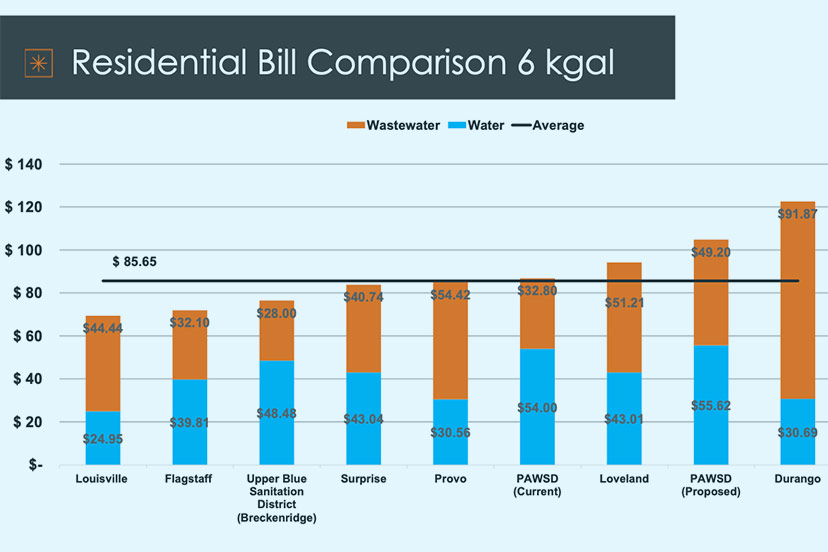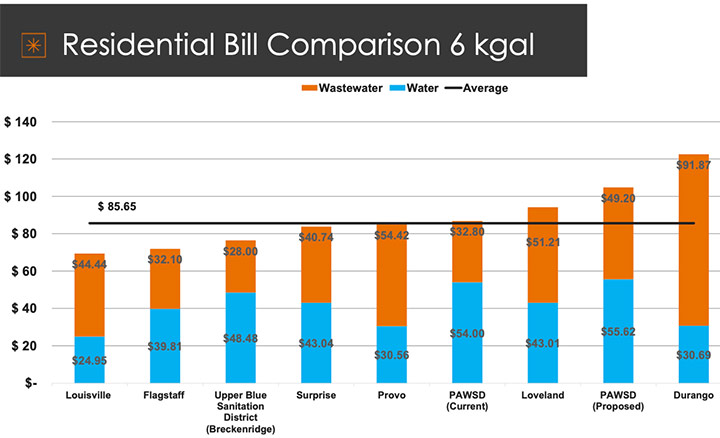We are really focused on doing projects, building more stuff, and we don’t really care, at all… about the cost. It’s really a very low priority for us, how much things cost…
— Civil engineer Chuck Marohn in a StrongTowns.org podcast, August 2023.
As mentioned earlier in this editorial series, many local governments in Pagosa Springs are entering ‘budget season’, during which decisions will be made about how to spend public revenues in 2024.
I will be attending a meeting of the Pagosa Area Water and Sanitation District (PAWSD) board of directors tomorrow, to discuss proposed increased fees for water and wastewater treatment.
Disclosure: I currently serve on the PAWSD Board of Directors, but I’m not speaking for the Board here… I’m sharing only my own opinions.
PAWSD recently approved a contract for a new water treatment plant on Snowball Road, to replace the aging treatment plant there. The cost of the plant will be more than $40 million, making it one of the most expensive infrastructure projects ever proposed in Archuleta County. Some of that cost will be paid for via taxes, but most will ultimately come from water customer fees.
Thus, a ‘rate study’ will be discussed tomorrow. How much will your PAWSD fees increase over the next ten years, to pay for ongoing operations and maintenance, plus new capital projects?
If you are on a fixed income, or struggling to get by on tourism industry wages, how will these higher costs affect you?
Before we get into the PAWSD numbers, a comment about government investments. In November 2021, the U.S. Congress passed the ‘Infrastructure Investment and Jobs Act’… also known as the ‘Bipartisan Infrastructure Deal’.
The White House shared its excitement about the $1 trillion ‘deal’:
This Bipartisan Infrastructure Deal will rebuild America’s roads, bridges and rails, expand access to clean drinking water, ensure every American has access to high-speed internet, tackle the climate crisis, advance environmental justice, and invest in communities that have too often been left behind. The legislation will help ease inflationary pressures and strengthen supply chains by making long overdue improvements for our nation’s ports, airports, rail, and roads.
It will drive the creation of good-paying union jobs and grow the economy sustainably and equitably so that everyone gets ahead for decades to come. Combined with the President’s Build Back Framework, it will add on average 1.5 million jobs per year for the next 10 years…
The ‘Build Back Framework’ failed to gain traction, but a slimmed-down $500 billion ‘Inflation Reduction Act’ did get approved last summer, basically along party lines. The White House claims that this, too, will create jobs.
Since the 1930s, many Americans have become convinced that it’s the job of our federal, state, and local governments to ‘create jobs’. Job creation makes a certain sense, politically. We understand that an idle, unemployed population is a dangerous population. Also, we understand that tax-funded government spending is much appreciated by wealthy corporations.
Closer to home, PAWSD has signed a $40 million contract to build a new drinking water treatment plant on Snowball Road. The old treatment plant is still functioning, although not perfectly… but it is going to fail at some point… and even if that were not the case, it would be unable to service a fast-growing community, into the future…
…if, by some twist of fate, Pagosa Springs once again became a fast-growing community, like it was during the 1990s? (Recent indications have suggested a sluggish real estate market in 2023.)
One question the PAWSD Board will, I suspect, be considering: Who should pay for this $40 million improvement?
Current customers?
New development?
The tourism industry?
PAWSD has additionally been required, by the Colorado Department of Public Health and Environment (CDPHE), to upgrade its wastewater treatment infrastructure, to reduce nitrogen and phosphorus in the treatment plant discharge. That upgrade might cost $3 million. Or it might cost $20 million. We don’t know yet.
As far as I can tell, neither of these PAWSD projects are being touted as “jobs programs”. Certainly, these two projects are not likely to provide local jobs, because they will be built by out-of-town construction companies, who will bring in their own tradesmen and supervisors. That’s the case with many infrastructure projects in Archuleta County; they get handled by out-of-town contractors and their employees, allowing millions of local dollars to leave the community… while also putting additional pressure on housing.
At tomorrow’s PAWSD Board meeting, the directors will discuss a rate study being conducted by a global company called Stantec, with offices in several Colorado cities. You can download the Stantec slides here.
Here’s a graph from the Stantec presentation, showing the current and proposed PAWSD monthly rates for a customer who pays both water and sewer bills, and uses 6,000 gallons a month.
A couple of key numbers, regarding drinking water, in the draft Stantec rates:
1. Current customers would see their water bill increase, over the next 10 years, from $54 to about $67 per month.
2. A new home or business would pay about $9,000 to hook up to PAWSD water. This would cover District ‘buy-in’ (as a new shareholder of the existing drinking water system) plus a share of the Snowball expansion cost.
The cost of wastewater treatment is projected to increase more dramatically, however, as PAWSD looks ahead to a major sewer plant upgrade. Here are a couple of key numbers, regarding wastewater treatment, in the suggested Stantec rates:
1. Current customers would see their gradual sewer bill increase, over the next 10 years, from the current $33.80 to about $100 per month.
2. A new home or business would pay about $16,500 to hook up to PAWSD sewer. This would cover ‘buy-in’ as a new shareholder of the existing sewer, plus a share of an expensive Vista Wastewater Treatment Plant upgrade planned for 2030.
The cost for a new home to hook up to water and wastewater, then, would be about $25,500. (Current hook-up costs are about $5,500, which is relatively low for a Colorado mountain town.)
As we think about who should pay for required upgrades, and for expansions, it seems sensible that ‘new development’ ought to pay for expansions… and everyone ought to pay for any required upgrades.
One additional question. Is the tourism industry paying its fair share?



